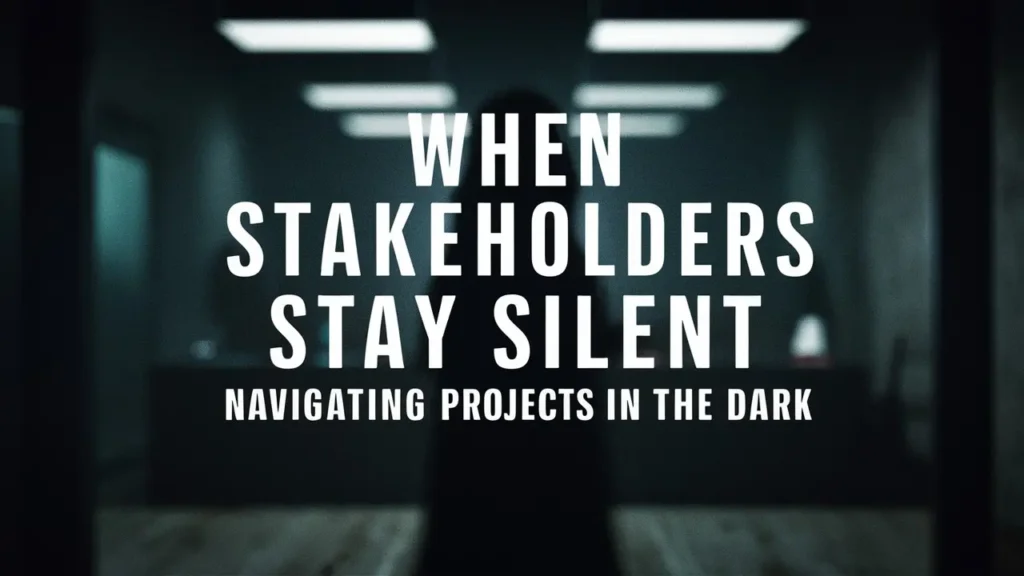Introduction
Imagine leading a project where the very people who are supposed to provide critical input keep you in the dark. When stakeholders don’t communicate, it can feel like you’re working in a vacuum—decisions are made without necessary insights, and progress becomes a guessing game. This scenario is all too common for project managers, and its impact can be profound: misaligned goals, delayed timelines, and mounting frustration among team members.
In this blog, we’ll explore when stakeholders stay silent, the consequences of poor communication, and actionable strategies to bring them out of the dark. Whether you’re an early-career project manager or a seasoned professional, these insights will help you handle silent stakeholders and ensure your project stays on track.
Actionable Tip: Before your next project meeting, prepare a list of targeted questions designed to elicit specific updates from stakeholders. Clear, focused questions can sometimes break the silence and spark the conversation you need.
1. Understanding the Silent Stakeholder Phenomenon
1.1 Why Stakeholders Stay Silent
Stakeholders may withhold communication for a variety of reasons:
Unclear Roles or Responsibilities: If they’re not sure what input is expected, they might choose to remain silent rather than provide incomplete or inaccurate information.
Fear of Criticism or Conflict: Some stakeholders avoid communication to steer clear of difficult conversations or potential blame.
Overwhelm and Busyness: Heavy workloads and conflicting priorities can lead to neglecting timely updates.
Cultural or Organizational Issues: In some environments, clear communication channels are lacking, or there’s a culture where feedback is not encouraged.
1.2 The Impact of Poor Communication
When stakeholders keep you in the dark:
Project Delays: Missing or delayed information can stall decision-making and slow project progress.
Misaligned Expectations: Without clear input, project objectives may deviate from what was originally planned.
Increased Stress: The uncertainty creates a challenging environment, making it harder to plan and execute tasks confidently.
Risk of Failure: Ultimately, silent stakeholders can jeopardize project success by preventing timely course corrections.
2. Strategies to Improve Stakeholder Communication
2.1 Establishing Clear Communication Channels
Define Channels Early: At the project’s outset, agree on primary communication channels—whether it’s email, Slack, Microsoft Teams, or regular in-person meetings.
Document Communication Plans: Share a communication plan that outlines how and when updates will be provided.
Set Response Time Expectations: Establish clear guidelines on how quickly stakeholders should respond to inquiries.
2.2 Regular One-on-One Meetings
Personalized Engagement: Schedule regular one-on-one meetings with key stakeholders to build trust and encourage candid updates.
Tailored Questions: Prepare specific, open-ended questions relevant to each stakeholder’s responsibilities.
Build Rapport: Use these sessions to understand any challenges they face, which may be contributing to their silence.
2.3 Setting Expectations Early and Often
Kick-Off Meetings: Clearly articulate roles, responsibilities, and the importance of timely communication during project kick-off meetings.
Regular Reminders: Periodically remind stakeholders of their communication commitments through status meetings or updates.
Feedback Loops: Create an environment where feedback is welcomed and acted upon, reinforcing the value of their input.
2.4 Being Direct While Balancing Empathy
Many project managers, including myself, have experienced the challenge of holding stakeholders accountable when they work in silos. I’ve often found myself stuck in situations where I need to get updates, but the stakeholders don’t keep me informed. While it might be tempting to beat around the bush, I’ve learned that being direct—though sometimes uncomfortable—is often more effective.
Set Clear Expectations: Define upfront how and when updates should occur. Utilize daily stand-ups, reports, and tools like Slack or Microsoft Teams, and have these guidelines agreed upon in your team charter.
Direct Communication: When updates are delayed, address the issue directly. For example, “I noticed we haven’t received the update on [specific task]. Is there a challenge I can help unblock?” This approach is not about placing blame, but about ensuring the project stays on track.
Balance with Empathy: It’s important to pair directness with empathy. Acknowledge any obstacles they might be facing and offer your support. This creates a safe space where team members can disclose blockers without feeling singled out.
Hold Accountability: If a stakeholder consistently works in isolation without sharing updates, document these instances and, if necessary, escalate the issue tactfully with your manager or sponsor. Provide data to back up your concerns, emphasizing how the lack of communication affects the project.
Actionable Tip: In your next project meeting, consider starting with a round of direct yet empathetic questions. For example, “I’ve noticed we haven’t received updates on X, and I’m concerned about potential risks. How can I help you overcome any obstacles?”
3. Tactics for Handling Non-Responsive Stakeholders
Even with robust strategies in place, some stakeholders may remain unresponsive. Here are some tactical approaches:
3.1 Accountability When Updates Are Missing
Direct Engagement: Address non-responsiveness head-on by asking clear, direct questions about specific deliverables.
Highlight the Impact: Explain how their silence could lead to missed deadlines or project delays, emphasizing that this isn’t a personal criticism but a necessary step to safeguard the project.
Offer Assistance: Ask if there’s anything you can do to help unblock their progress. This not only shows your support but also reinforces accountability.
3.2 Escalation Processes
Document Communication Attempts: Keep a record of all your attempts to get updates. This documentation is critical if the issue needs to be escalated.
Managerial Escalation: If one-on-one efforts fail, escalate the issue to their immediate manager or project sponsor. Outline the potential impact on project timelines and quality.
Formal Reporting: Use formal channels, such as the project risk or issue log, to flag the communication gap. This ensures that the problem is visible to higher management.
3.3 Leveraging Documentation and Transparency
Centralized Dashboard: Maintain a transparent project dashboard that documents all updates, decisions, and responsibilities. This helps hold everyone accountable.
Detailed Meeting Minutes: Distribute comprehensive meeting minutes that capture decisions and assign action items clearly.
Reference Approved Plans: Regularly refer back to the approved project plan and schedule. Showing stakeholders the baseline expectations can prompt them to provide the necessary updates.
3.4 Using Technology to Bridge Communication Gaps
Automated Reminders: Utilize project management tools that automatically send reminders for updates and task completions.
Collaboration Platforms: Leverage tools like Microsoft Teams, Slack, or Asana to facilitate real-time communication and collaboration.
Surveys and Polls: Implement quick surveys or polls to gather stakeholder input, which might be less intimidating than direct requests.
Actionable Tip: If a stakeholder continues to be unresponsive, document the impact on the project and raise the issue in your next review meeting. This reinforces the importance of communication and accountability.
4. Real-World Scenario: The ERP Implementation Roadblock
The Situation:
In an ERP implementation project at a mid-sized manufacturing company, the project manager was responsible for integrating several key modules within a tight deadline. One critical module, managed by the IT department, required frequent updates and precise inputs to align with the overall project timeline. However, the designated IT stakeholder consistently failed to provide updates and operated in isolation. This lack of communication led to misaligned expectations, delays in task completion, and growing concern among the project team about potential risks to the project’s success.
The Challenge:
Lack of Updates: The IT stakeholder was not responding to emails or meeting invitations, leaving the project manager in the dark about progress.
Siloed Work: The stakeholder was working independently, which resulted in information gaps and misaligned deliverables.
Impact on the Project: With no clarity on the IT module’s progress, overall project timelines began to slip, risking delays in the final rollout.
How It Was Solved:
Direct One-on-One Engagement:
The project manager arranged a private one-on-one meeting with the unresponsive IT stakeholder. During this session, the manager was candid yet empathetic:Direct Questioning: “I’ve noticed we haven’t received the update on the IT module. Could you share what challenges you’re facing or if there’s anything preventing you from providing regular updates?”
Understanding Barriers: The stakeholder revealed that conflicting priorities and unclear expectations were causing delays. They felt unsure about the required level of detail for their updates.
Setting Clear Expectations:
Following the meeting, the project manager collaborated with the IT stakeholder to define specific communication expectations:Defined Update Schedule: It was agreed that brief daily stand-ups and a detailed weekly update would be mandatory.
Documentation: The agreed-upon communication process was documented in the project charter, ensuring both parties had a clear reference.
Leveraging Technology and Tools:
To facilitate smoother communication, the team integrated a shared dashboard using Microsoft Teams and Asana:Automated Reminders: The system was set up to automatically remind the IT stakeholder to update their task status.
Real-Time Visibility: The dashboard allowed the entire project team to track progress and quickly identify if updates were missing.
Balancing Directness with Empathy:
The project manager maintained a direct approach while showing understanding:Supportive Check-Ins: “I know these updates can be challenging with your current workload. Is there any way I can help to ensure that we stay on track?”
Offering Assistance: The manager offered help by coordinating with other team members to share some of the workload, ensuring the IT stakeholder was not overwhelmed.
Escalation as a Last Resort:
After a few weeks, when the agreed communication processes started yielding consistent updates, the situation improved markedly. However, the project manager had already documented the lack of earlier responses, which served as a backup if further escalation were needed.
The Outcome:
Within a few weeks, the IT stakeholder began providing regular and detailed updates. The improved communication helped align the IT module with the overall project schedule, and potential risks were mitigated early on. The project was delivered on time, and the experience led to the adoption of clearer communication guidelines across future projects.
5. Conclusion
When stakeholders don’t communicate, it can feel like you’re operating in the dark—making it harder to drive your project to success. However, by establishing clear communication channels, scheduling regular one-on-one meetings, setting expectations early, and balancing directness with empathy, you can mitigate the risks associated with silent stakeholders. As a project manager, your proactive efforts not only protect the project’s progress but also foster a culture of transparency and accountability.
Final Actionable Tip: In your next project meeting, address any gaps in communication head-on with clear, empathetic questions. Hold your team accountable and, if necessary, escalate issues with supporting data to ensure your project stays on track.








